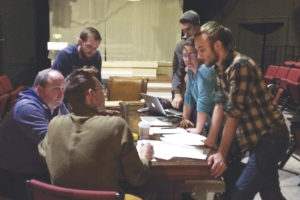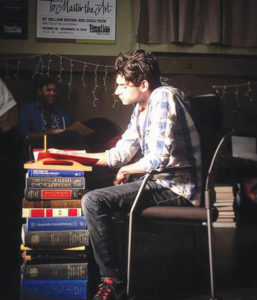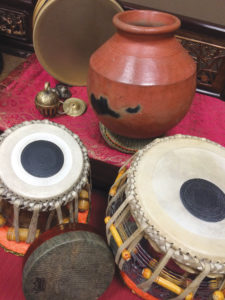A Disappearing Number calls for projections, mathematics on stage, live music, Indian dance, time travel, altered sound and a set that magically transforms itself. When first created by Complicite, the play was devised collaboratively, and TimeLine’s approach to this new production also has been incredibly collaborative. Much of the team began production meetings back in June!
To talk about this intense collaborative process, I decided to ask the production team a few questions.
Maren Robinson [Dramaturg] (MR): What excited or scared you most when you became a part of this production?
Nick Bowling [Director] (NB): I have never been more daunted by a play. When the company all agreed upon it, we knew that what Simon McBurney and Complicite were asking of the directing and design team was to create a world that helps illuminate the importance and beauty of mathematical ideas like infinity, while telling two intertwining love stories. I love that challenge, but it scared me more than any other play has scared me before.

I knew that in order to take on this project I needed to surround myself with a production team who could give me the time, energy and ideas needed to help create this world for the actors—not just come inside my brain but allow me into their brains, as well. It has meant that there are more cooks in the kitchen and required a huge amount of trust and collaboration (I’ve never had more meetings in my life!), but it has helped the production and me grow.
William Carlos Angulo [Choreographer] (WCA): I was most excited by the challenge of the piece. The ideas of the show rely heavily on our ability to enter someone’s mind—to bring flesh to the abstract and to bring the ethereal to the ground. Creating these big, cohesive images demands a kind of collaboration from designers, production, and actors different than I’ve ever attempted. It’s both exciting and intimidating.
Eva Breneman [Dialect Coach] (EB): I fell in love with the script—with the challenges posed by the prismatic storytelling, and the difficulty of understanding the math and then communicating that understanding to the audience. Then for my part in the show, the difficulty in delicately and authentically help the actors with the various forms of Indian dialect.
Alka Nayyar [Associate Director] (AN): Oh no, it’s a play about math. Wait, it’s about love? I can do that. This concept of infinity though … I am gripped.
Language, movement, dialect, dance—it’s all about timing. And timing is all mathematics. I’m no mathematician and I’ll admit an apprehension about doing (even not-so-advanced) math myself, but I have always had the utmost respect for it as a philosophy and a science. As an intrinsic, integral, inseparable part of daily life. As a force behind everything. So I always felt the implicit math in dance (especially while teaching), in the meter of words and phrasing, and of course in music.
But I hadn’t understood math as the art in and of itself. Not just the device or the means to an end, but math as the end. And for those of us who equate love with art, with the inexplicably divine—that which simply is—isn’t that just math?

Getting a glimpse into the universality and infinite possibility of mathematics through the writing of G.H. Hardy and S. Ramanujan was both overwhelming and exhilarating. Every attempt I made at breaking down scenes in my mind was fraught.
Then Nick’s vision for the play helped me understand it as one elegant movement, in and out of time. I see it as mathematicians, lovers, workers, teachers, children, geniuses, parents, all of us on the continuum “consciously or unconsciously … trying to unfold that divinity” as Swami Vivekananda explained. Each of us attempting to understand ourselves. Or, the infinite. That which simply is.
Also, while I have a decent working knowledge of Indian dance, cultures, philosophies, religions, customs and history, I don’t speak Tamil. And it was key for several characters to have an accurate feel for the Tamil language. Thankfully, I have a resource in an incredible artist, musician and friend, the multilingual Saraswathi Ranganathan.
MR: What are the challenges or perhaps strange synchronicities that emerged as you thought about how math might be represented in your work on stage?
William Boles [Scenic Designer] (WB): It’s funny, I’ve had to do a lot more math than usual while working on this piece. So much of the scenic design is blended in to allow other design elements and the action of the play to smoothly function. To do this we really had to distill down to what few elements we needed to tell the story and make them easy to use by the actors. It was a blending of ideas and utilitarian function.
WCA: Dance and music both rely heavily on numbers to operate. And both are inherently emotional mediums. The intersection of numbers and emotion (though very useful to the play) is a difficult thing to wrap our minds around. Music and dance both help us to understand the emotional implication of this material. Whereas music is the ethereal, untouchable expression, dance is 100 percent physical. Nothing does what dance does. It is the most fully realized physical expression of emotion that exists. It literally gives life to the unseen. It gives a body to the numbers—literally gives them a breath and a pulse.
EB: I started from a place of total horror! Higher math has always eluded me—I think I understand a concept but then it disappears from my brain almost on contact. As I’ve worked on this play I’ve really started to glimpse the beauty of math from the corner of my eye.
NB: When I first read A Disappearing Number, I was surprisingly moved by this play about math. Most artists hate numbers, but I was always innately better at math than language. And I have found many ways to use it while directing—perhaps the most obvious being the geometry used in staging a play in the “alley” set up I so often use and love.
I’ll admit an apprehension about doing math myself, but I have always had the utmost respect for it as a philosophy and a science. As an intrinsic, integral, inseparable part of daily life. – Alka Nayyar, Associate Director
MR: The play is also about contrasts. In rehearsal we talked about a series of binaries: India/England, math/non-mathematical, and past/present. What did you draw on in your work to bring out these different aspects of the play?
Rachel Levy [Lighting Designer] (RL): Contrast and patterns are probably the two largest elements of my design concept. I am hoping to highlight them with three main ideas. First, we have a “neutral” look. Second, I have created a grid of colorless light lines to accentuate a more mathematical, systematic idea while we transition back and forth through time. And third, I’m trying to create a completely separate idea full of color, romance and freedom to transport us to the spiritual. Although these ideas contrast one another, my aim is that they all are beautiful in their own way and therefore, support the action on stage.
WCA: The contrast between the beautiful and the mundane is the binary that has really been lodged in my throat for the past several months. The idea of pure mathematics—math that serves a purely aesthetic purpose—I had never even considered this. To me, numbers feel mundane … every-day tools.
But the characters in this play view numbers in both ways. Beautiful and mundane. The text forces us to ask ourselves to define beauty—our own kind of beauty—and it has, in turn, forced me to ask myself the same question of the movement I develop with the ensemble. When does it need to be mundane … comfortable… expected? And when does it need to be beautiful … fantastical … unworldly? What mind are we in? What reality are we creating?
EB: Hmm. My work is less about binary and more about degrees—degrees of fluency in English, degrees of education, and how that translates into the technicalities of the accent. But as a theatre collaborator, the symmetry of these binary pairs is deeply satisfying, another example of beauty in math.

AN: I felt it was important to see, hear and feel mathematics in ways that would help our audience go beyond just numbers on a screen or a chalkboard. One of the ways Ronnie [Malley] and Bob [Garrett] (our musicians) have helped us accomplish this is in picking rhythm cycles that speak to the text—the numbers and patterns and symmetries in the text—and we imagine what that series of numbers “feels” like as an underscore.
MR: Artistic Director PJ Powers often says that it “takes a village” to put up a play. Yet, for those of us not on stage the work often disappears seamlessly into the production. What is it about your work that you most wish audiences understand or take away?
EB: I hope that my work illumines the play—I hope that the audience never notices the “seams,” as it were. The dialects and the acting should merge fluidly together. But if the audience does notice, I hope they understand the necessity of presenting these ideas in dialect, that telling stories in different accents is necessary to open our eyes to the world.
WCA: It is purposeful. It is all purposeful. Search for the meaning in it. It’s there. Even when it’s incredibly difficult to find, it’s there.
NB: I think people see the director as the person who drives the bus and tells everyone what to do.
Actually, it’s not true. I see myself more as a back-seat driver—someone who has a different perspective on the ride than the actual drivers (the actor, the designer, etc.). They are the artists, and my job is to help manage the show. To push people to do their best work and to hopefully bring the elements of that work into a cohesive whole. True, I often start in the driver’s seat and I get to pick many of the passengers, but ultimately, it’s their work.
And while the director is the person who makes the final decisions about the big choices that get made in the production, that doesn’t mean I think of them or that I even know how to implement them. That’s certainly the case with this show! The toughest part of my job is often when there is more than one good choice and I have to be the one to choose.
AN: My hope is that it’s understood implicitly and that our collaborative input on and off stage is alive in the work done on stage.
MR: What are the ways that you find yourself collaborating with others in the production team that are different from some other productions?
AN: I’m fortunate to be in the room with an extraordinary team on A Disappearing Number. For starters, we had few (read: no) guideposts, which is always nerve-wracking and exciting. But delving into this—with all inhibitions about ever understanding the functional equation of the Riemann zeta function intact—has been a worthy challenge.
I’ve had the opportunity to collaborate with musicians Ronnie and Bob on what we think the coolest “taal” (beat) or melody would be for certain moments, while I watch William clarify the abstract with beautiful, mathematical movement, and we incorporate elements of Indian classical dance and inspiration from Ramanujan’s Hindu faith. I’ve thoroughly enjoyed riffing off of Eva’s expertise in dialect and text work, and have been delighted to add what I could to Maren’s tremendous dramaturgical efforts.
From food and props, to costumes, to historical info, to sounds, song, gestures and movement—thanks to our marvelous cast, talented designers and of course, Nick, I’ve been lucky to be a part of so many aspects of the production.
EB: I have had the greatest good fortune to have Alka as a partner in this show—she has been invaluable in bringing things to my attention that I would have totally missed. And she speaks the same “language” when it comes to working with actors that I do, which has made it extraordinarily easy to work together as a team.
NB: I’ve been so lucky on this production to have surrounded myself with such smart and talented teammates. A few, like Misha [Mikhail Fiksel, Sound Designer], Eva, Sally [Dolembo, Costume Designer], Vivian [Knouse, Properties Designer] and Maren are invaluable collaborators who have worked with me on so many plays that we speak in shorthand.
Others like William and William, Rachel and Davonte [Rasean Davonte Johnson, Projections Designer] are new to me and were brought on board specifically to push us in directions I never expected. My associate director Alka was involved to give us support on all things Indian, but she has done so much more than that, affecting the production in ways I would never have guessed.

One Response to “An intense collaborative process”
Frances Brantley
Thank you for your work on this extraordinary effort.